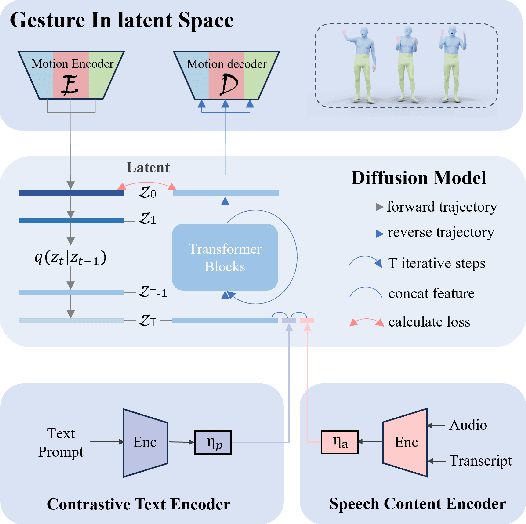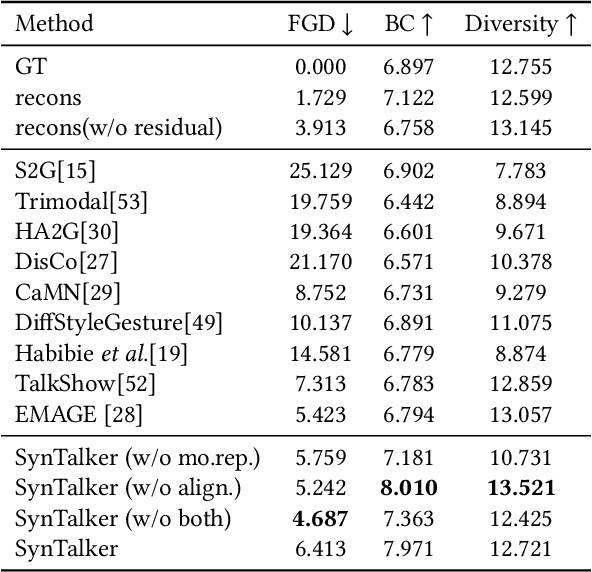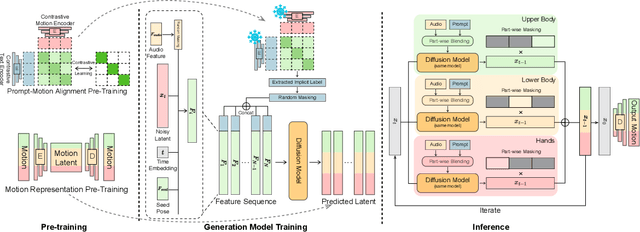Tianjia Shao
When Gaussian Meets Surfel: Ultra-fast High-fidelity Radiance Field Rendering
Apr 24, 2025Abstract:We introduce Gaussian-enhanced Surfels (GESs), a bi-scale representation for radiance field rendering, wherein a set of 2D opaque surfels with view-dependent colors represent the coarse-scale geometry and appearance of scenes, and a few 3D Gaussians surrounding the surfels supplement fine-scale appearance details. The rendering with GESs consists of two passes -- surfels are first rasterized through a standard graphics pipeline to produce depth and color maps, and then Gaussians are splatted with depth testing and color accumulation on each pixel order independently. The optimization of GESs from multi-view images is performed through an elaborate coarse-to-fine procedure, faithfully capturing rich scene appearance. The entirely sorting-free rendering of GESs not only achieves very fast rates, but also produces view-consistent images, successfully avoiding popping artifacts under view changes. The basic GES representation can be easily extended to achieve anti-aliasing in rendering (Mip-GES), boosted rendering speeds (Speedy-GES) and compact storage (Compact-GES), and reconstruct better scene geometries by replacing 3D Gaussians with 2D Gaussians (2D-GES). Experimental results show that GESs advance the state-of-the-arts as a compelling representation for ultra-fast high-fidelity radiance field rendering.
Real-time High-fidelity Gaussian Human Avatars with Position-based Interpolation of Spatially Distributed MLPs
Apr 17, 2025Abstract:Many works have succeeded in reconstructing Gaussian human avatars from multi-view videos. However, they either struggle to capture pose-dependent appearance details with a single MLP, or rely on a computationally intensive neural network to reconstruct high-fidelity appearance but with rendering performance degraded to non-real-time. We propose a novel Gaussian human avatar representation that can reconstruct high-fidelity pose-dependence appearance with details and meanwhile can be rendered in real time. Our Gaussian avatar is empowered by spatially distributed MLPs which are explicitly located on different positions on human body. The parameters stored in each Gaussian are obtained by interpolating from the outputs of its nearby MLPs based on their distances. To avoid undesired smooth Gaussian property changing during interpolation, for each Gaussian we define a set of Gaussian offset basis, and a linear combination of basis represents the Gaussian property offsets relative to the neutral properties. Then we propose to let the MLPs output a set of coefficients corresponding to the basis. In this way, although Gaussian coefficients are derived from interpolation and change smoothly, the Gaussian offset basis is learned freely without constraints. The smoothly varying coefficients combined with freely learned basis can still produce distinctly different Gaussian property offsets, allowing the ability to learn high-frequency spatial signals. We further use control points to constrain the Gaussians distributed on a surface layer rather than allowing them to be irregularly distributed inside the body, to help the human avatar generalize better when animated under novel poses. Compared to the state-of-the-art method, our method achieves better appearance quality with finer details while the rendering speed is significantly faster under novel views and novel poses.
High-fidelity 3D Object Generation from Single Image with RGBN-Volume Gaussian Reconstruction Model
Apr 02, 2025Abstract:Recently single-view 3D generation via Gaussian splatting has emerged and developed quickly. They learn 3D Gaussians from 2D RGB images generated from pre-trained multi-view diffusion (MVD) models, and have shown a promising avenue for 3D generation through a single image. Despite the current progress, these methods still suffer from the inconsistency jointly caused by the geometric ambiguity in the 2D images, and the lack of structure of 3D Gaussians, leading to distorted and blurry 3D object generation. In this paper, we propose to fix these issues by GS-RGBN, a new RGBN-volume Gaussian Reconstruction Model designed to generate high-fidelity 3D objects from single-view images. Our key insight is a structured 3D representation can simultaneously mitigate the afore-mentioned two issues. To this end, we propose a novel hybrid Voxel-Gaussian representation, where a 3D voxel representation contains explicit 3D geometric information, eliminating the geometric ambiguity from 2D images. It also structures Gaussians during learning so that the optimization tends to find better local optima. Our 3D voxel representation is obtained by a fusion module that aligns RGB features and surface normal features, both of which can be estimated from 2D images. Extensive experiments demonstrate the superiority of our methods over prior works in terms of high-quality reconstruction results, robust generalization, and good efficiency.
Enhancing Visual Reasoning with Autonomous Imagination in Multimodal Large Language Models
Nov 27, 2024Abstract:There have been recent efforts to extend the Chain-of-Thought (CoT) paradigm to Multimodal Large Language Models (MLLMs) by finding visual clues in the input scene, advancing the visual reasoning ability of MLLMs. However, current approaches are specially designed for the tasks where clue finding plays a major role in the whole reasoning process, leading to the difficulty in handling complex visual scenes where clue finding does not actually simplify the whole reasoning task. To deal with this challenge, we propose a new visual reasoning paradigm enabling MLLMs to autonomously modify the input scene to new ones based on its reasoning status, such that CoT is reformulated as conducting simple closed-loop decision-making and reasoning steps under a sequence of imagined visual scenes, leading to natural and general CoT construction. To implement this paradigm, we introduce a novel plug-and-play imagination space, where MLLMs conduct visual modifications through operations like focus, ignore, and transform based on their native reasoning ability without specific training. We validate our approach through a benchmark spanning dense counting, simple jigsaw puzzle solving, and object placement, challenging the reasoning ability beyond clue finding. The results verify that while existing techniques fall short, our approach enables MLLMs to effectively reason step by step through autonomous imagination. Project page: https://future-item.github.io/autoimagine-site.
Enabling Synergistic Full-Body Control in Prompt-Based Co-Speech Motion Generation
Oct 01, 2024



Abstract:Current co-speech motion generation approaches usually focus on upper body gestures following speech contents only, while lacking supporting the elaborate control of synergistic full-body motion based on text prompts, such as talking while walking. The major challenges lie in 1) the existing speech-to-motion datasets only involve highly limited full-body motions, making a wide range of common human activities out of training distribution; 2) these datasets also lack annotated user prompts. To address these challenges, we propose SynTalker, which utilizes the off-the-shelf text-to-motion dataset as an auxiliary for supplementing the missing full-body motion and prompts. The core technical contributions are two-fold. One is the multi-stage training process which obtains an aligned embedding space of motion, speech, and prompts despite the significant distributional mismatch in motion between speech-to-motion and text-to-motion datasets. Another is the diffusion-based conditional inference process, which utilizes the separate-then-combine strategy to realize fine-grained control of local body parts. Extensive experiments are conducted to verify that our approach supports precise and flexible control of synergistic full-body motion generation based on both speeches and user prompts, which is beyond the ability of existing approaches.
GenesisTex2: Stable, Consistent and High-Quality Text-to-Texture Generation
Sep 27, 2024



Abstract:Large-scale text-guided image diffusion models have shown astonishing results in text-to-image (T2I) generation. However, applying these models to synthesize textures for 3D geometries remains challenging due to the domain gap between 2D images and textures on a 3D surface. Early works that used a projecting-and-inpainting approach managed to preserve generation diversity but often resulted in noticeable artifacts and style inconsistencies. While recent methods have attempted to address these inconsistencies, they often introduce other issues, such as blurring, over-saturation, or over-smoothing. To overcome these challenges, we propose a novel text-to-texture synthesis framework that leverages pretrained diffusion models. We first introduce a local attention reweighing mechanism in the self-attention layers to guide the model in concentrating on spatial-correlated patches across different views, thereby enhancing local details while preserving cross-view consistency. Additionally, we propose a novel latent space merge pipeline, which further ensures consistency across different viewpoints without sacrificing too much diversity. Our method significantly outperforms existing state-of-the-art techniques regarding texture consistency and visual quality, while delivering results much faster than distillation-based methods. Importantly, our framework does not require additional training or fine-tuning, making it highly adaptable to a wide range of models available on public platforms.
Interactive Rendering of Relightable and Animatable Gaussian Avatars
Jul 15, 2024



Abstract:Creating relightable and animatable avatars from multi-view or monocular videos is a challenging task for digital human creation and virtual reality applications. Previous methods rely on neural radiance fields or ray tracing, resulting in slow training and rendering processes. By utilizing Gaussian Splatting, we propose a simple and efficient method to decouple body materials and lighting from sparse-view or monocular avatar videos, so that the avatar can be rendered simultaneously under novel viewpoints, poses, and lightings at interactive frame rates (6.9 fps). Specifically, we first obtain the canonical body mesh using a signed distance function and assign attributes to each mesh vertex. The Gaussians in the canonical space then interpolate from nearby body mesh vertices to obtain the attributes. We subsequently deform the Gaussians to the posed space using forward skinning, and combine the learnable environment light with the Gaussian attributes for shading computation. To achieve fast shadow modeling, we rasterize the posed body mesh from dense viewpoints to obtain the visibility. Our approach is not only simple but also fast enough to allow interactive rendering of avatar animation under environmental light changes. Experiments demonstrate that, compared to previous works, our method can render higher quality results at a faster speed on both synthetic and real datasets.
Pattern Guided UV Recovery for Realistic Video Garment Texturing
Jul 14, 2024



Abstract:The fast growth of E-Commerce creates a global market worth USD 821 billion for online fashion shopping. What unique about fashion presentation is that, the same design can usually be offered with different cloths textures. However, only real video capturing or manual per-frame editing can be used for virtual showcase on the same design with different textures, both of which are heavily labor intensive. In this paper, we present a pattern-based approach for UV and shading recovery from a captured real video so that the garment's texture can be replaced automatically. The core of our approach is a per-pixel UV regression module via blended-weight multilayer perceptrons (MLPs) driven by the detected discrete correspondences from the cloth pattern. We propose a novel loss on the Jacobian of the UV mapping to create pleasant seams around the folding areas and the boundary of occluded regions while avoiding UV distortion. We also adopts the temporal constraint to ensure consistency and accuracy in UV prediction across adjacent frames. We show that our approach is robust to a variety type of clothes, in the wild illuminations and with challenging motions. We show plausible texture replacement results in our experiment, in which the folding and overlapping of the garment can be greatly preserved. We also show clear qualitative and quantitative improvement compared to the baselines as well. With the one-click setup, we look forward to our approach contributing to the growth of fashion E-commerce.
ElastoGen: 4D Generative Elastodynamics
May 23, 2024Abstract:We present ElastoGen, a knowledge-driven model that generates physically accurate and coherent 4D elastodynamics. Instead of relying on petabyte-scale data-driven learning, ElastoGen leverages the principles of physics-in-the-loop and learns from established physical knowledge, such as partial differential equations and their numerical solutions. The core idea of ElastoGen is converting the global differential operator, corresponding to the nonlinear elastodynamic equations, into iterative local convolution-like operations, which naturally fit modern neural networks. Each network module is specifically designed to support this goal rather than functioning as a black box. As a result, ElastoGen is exceptionally lightweight in terms of both training requirements and network scale. Additionally, due to its alignment with physical procedures, ElastoGen efficiently generates accurate dynamics for a wide range of hyperelastic materials and can be easily integrated with upstream and downstream deep modules to enable end-to-end 4D generation.
X-SLAM: Scalable Dense SLAM for Task-aware Optimization using CSFD
May 03, 2024Abstract:We present X-SLAM, a real-time dense differentiable SLAM system that leverages the complex-step finite difference (CSFD) method for efficient calculation of numerical derivatives, bypassing the need for a large-scale computational graph. The key to our approach is treating the SLAM process as a differentiable function, enabling the calculation of the derivatives of important SLAM parameters through Taylor series expansion within the complex domain. Our system allows for the real-time calculation of not just the gradient, but also higher-order differentiation. This facilitates the use of high-order optimizers to achieve better accuracy and faster convergence. Building on X-SLAM, we implemented end-to-end optimization frameworks for two important tasks: camera relocalization in wide outdoor scenes and active robotic scanning in complex indoor environments. Comprehensive evaluations on public benchmarks and intricate real scenes underscore the improvements in the accuracy of camera relocalization and the efficiency of robotic navigation achieved through our task-aware optimization. The code and data are available at https://gapszju.github.io/X-SLAM.
 Add to Chrome
Add to Chrome Add to Firefox
Add to Firefox Add to Edge
Add to Edge